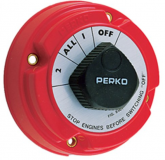I assume you are talking about a circuit like Will shows in several of his videos where he uses the 'load' wire from the BMS to activate a battery disconnect. (Or a big solenoid).
The 'dangerous' point is when the Victron battery protect first turns on. At this point there will be a large but short surge while the capacitors in your inverter charge. I don't know what the current will be but it will briefly spike quite high and then immediately start tapering off. The current will be back down to near steady state in well under a second.
You will have 4 items in the path of that current.
1) Inverter. A 12V 3000W inverter is in the area where the surge current will be quite high, but like I said in my last post, I am not sure how the surge would hurt the inverter. All that energy is going directly into the capacitors.
2) Battery. A big current spike is not good for the battery, but the spike is so short it probably does not matter. (There won't be time for the battery to heat up much and heat is what causes the problems.)
Note: I don't think there is anything to worry about with the battery but, it will be almost impossible for the average Joe to know if there is a problem. If there is damage to the battery, it will almost certainly be something that is not immediately detectable. Furthermore, if there is a problem it is probably a cumulative effect. Consequently, if it does not happen very often, you will never notice it.
3) Victron Battery protect

Like I said, I don't know what the peak current is so I don't know if it would exceed the 600A Peak spec of the victron. However, the surge will have tapered down in significantly less than a second. Furthermore, Victron equipment is usually built quite well. If there were a problem with inverter loads, my guess is Victron would either design to deal with it or put something in the manual to warn about it.
When the Victron is signaled to disconnect, it is an entirely different (Easier) situation. At that point, we are 'only' talking about turning off the steady state load. Since the Victron was designed as a disconnect device to protect the battery, I am confident it will be able to handle the situation you describe without worry. (Note: The inverter will act as a capacitive load so I am not concerned about voltage spikes. If you had an inductive load (like Motors) I would be a more concerned about voltage spikes on disconnect. )
Conclusion:Based on my logic above, I don't think there is an issue.
The primary reason I am concerned about the turn-on-surge is that the BMS boards tend to be less robust than Victron and we have seen from the videos that the over-current protect of the BMS boards can trip when the start-surge happens.




